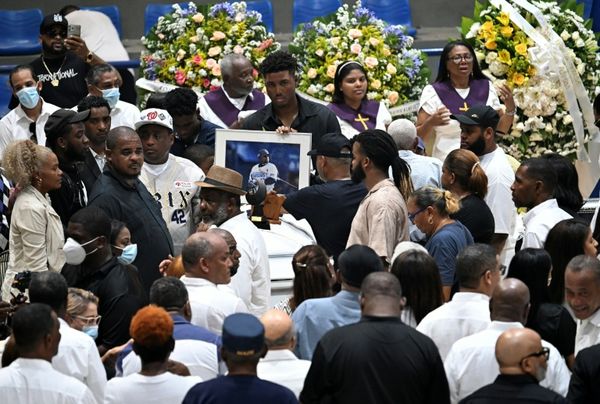There is a tell-tale rhythm to broadcasting a baseball game. The downtimes between pitches and at-bats are opportunities to opine, inform, or tell stories, as the greats have done.
A baseball broadcast is metronomic. It’s sometimes therapeutic. It’s nearly a podcast: Just a couple of guys in the booth, talking baseball or whatever else comes to mind, and sporadically calling the “action” on the diamond, too.
I’ve long considered the radio — or, to be more apt for 2023, the audio broadcast — to be the superior way to take in the game. You can pop in an earbud and do dishes, walk the dog, do yard work, or run errands. You’d know everything you needed to know about the game and you could get other stuff done in the process.
And I was legitimately excited to listen to Sunday’s Giants spring training game. I planned on making lunch for the family, folding clothes, and then driving into the city for the Warriors game. Jon Miller and Duane Kuiper were going to come along for the ride.
And they did. But a funny thing happened during the broadcast: The duo kept being interrupted.
Miller was trying to reference The Naked Gun’s legendary baseball sce— the 1-0 is in there for a strike. Fastball at the knees.
Kuiper tried to remember other players on the 1993 Colorado Rock— the 2-1 misses outside. The count is 3-and-1.
The duo was going over a list of great players who never made the postseason, and they simply could not — line drive to center field, it’s caught — get — there’s a high fastball, 1-2 — through — pickoff throw to first, not in time — it.
Major League Baseball’s new pitch timer has only been implemented for only a few days, but it has already turned the once-casual baseball broadcast into a semi-frantic affair. You could hear it in Miller and Kuiper’s voices. Eventually, the two legendary announcers caught up to the new rhythm of the game, but the pace never relented. The action of the game was steady and frequent.
Also, the game was over well before I parked at Chase Center.
I loved every second of it, even if there were fewer of them.
What’s bad for broadcasters’ anecdotes is great for the game. Baseball feels like a new, better sport with the pitch timer, which is 15 seconds with the bases empty and 20 seconds with runners on base.
Major League Baseball said that the length of spring training games is down 23 minutes from last season. It feels more significant than that.
The Giants played two action-packed games this past weekend. Saturday’s 10-8 loss to the Cubs featured 25 hits and 13 walks. The game was the longest of the early spring schedule. It took 3:06.
That’s the same amount of time the average MLB game took last season.
Sunday, the Giants were in another 25-hit affair. Their 7-6 win over the Reds lasted only 2:43.
With the new pitch clock, baseball has a chance to align with America’s other long-season professional sports — the NHL and NBA — on duration. Hockey games are routinely 2:20. Basketball games, 2:30.
The average NFL game lasts as long as the average Major League game in 2021: 3:11 minutes.
But your favorite baseball team plays every night. Your favorite NFL team plays once a week and features grown men colliding with each other at full speed.
In recent seasons, watching every inning your team plays weekly has taken roughly 20 hours. That’s a part-time job.
No sport has demanded more time to follow but done less to earn one’s attention in recent years than Major League Baseball. It’s why the game feels as if it’s dying.
The pitch clock might save it.
Conservatively, it will save two hours a week, per team. It could be more — we’ll see come the regular season.
But the timer also makes the game more enjoyable.
In addition to the larger bases (encouraging more steals), new pickoff rules (no more meaningless tosses to first), and a ban on the infield shift, the timer makes baseball feel like a sport again. The game has a punchiness to it — one I haven’t seen in nearly a decade.
For anyone who bemoans the loss of tradition, I recommend you watch an old game on YouTube. Before 2000, the average MLB game took less than 3 hours to play. In 1979, the average game took less than 2:30.
The pitch clock is turning back the clock.
I was lucky enough to grow up a White Sox fan in Chicago when Mark Buehrle was the team’s ace. The lefty didn’t throw hard, but he worked fast — crazy fast. Buehrle threw 10 games that lasted 2 hours or fewer in his career. In 2005, he threw a complete game that lasted only 99 minutes. I remember going to a mid-summer night game Buehrle started where the sun was still not fully set after the game ended.
Flipping around MLB.TV games these past few days, it’s like every pitcher is Buehrle.
Even Giants closer Camilo Doval — who, before the clock, used to take paid time off between pitches — is keeping up with the pace. It’s a modern miracle.
And while I don’t think it’s miraculous enough to reinstate baseball as the national pastime, perhaps it can stop the flow of fans away from the game and bring some new fans into the fold.
This pitch timer is a huge win for baseball. Yes, even if it means fewer stories from the broadcast booth.







